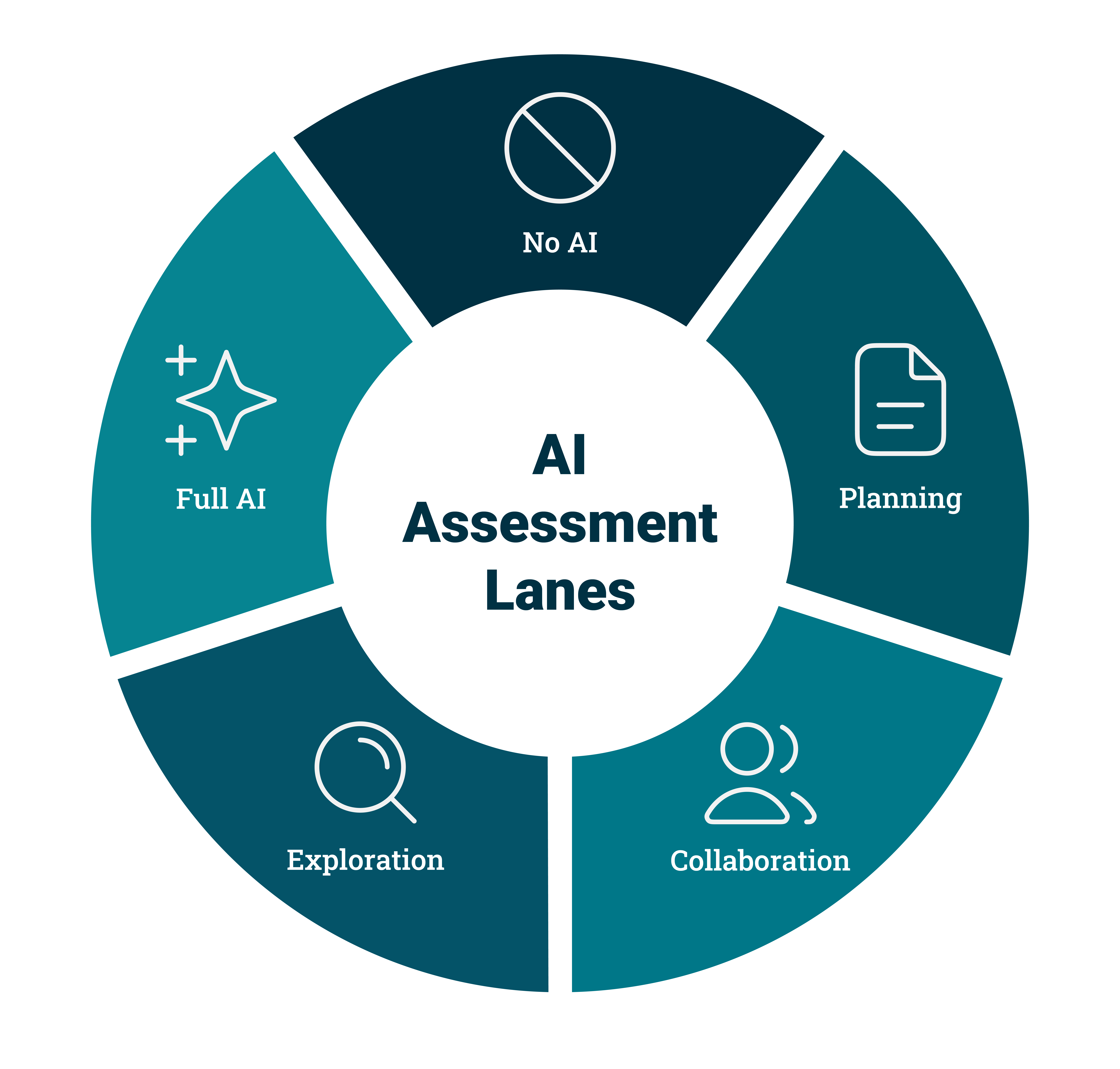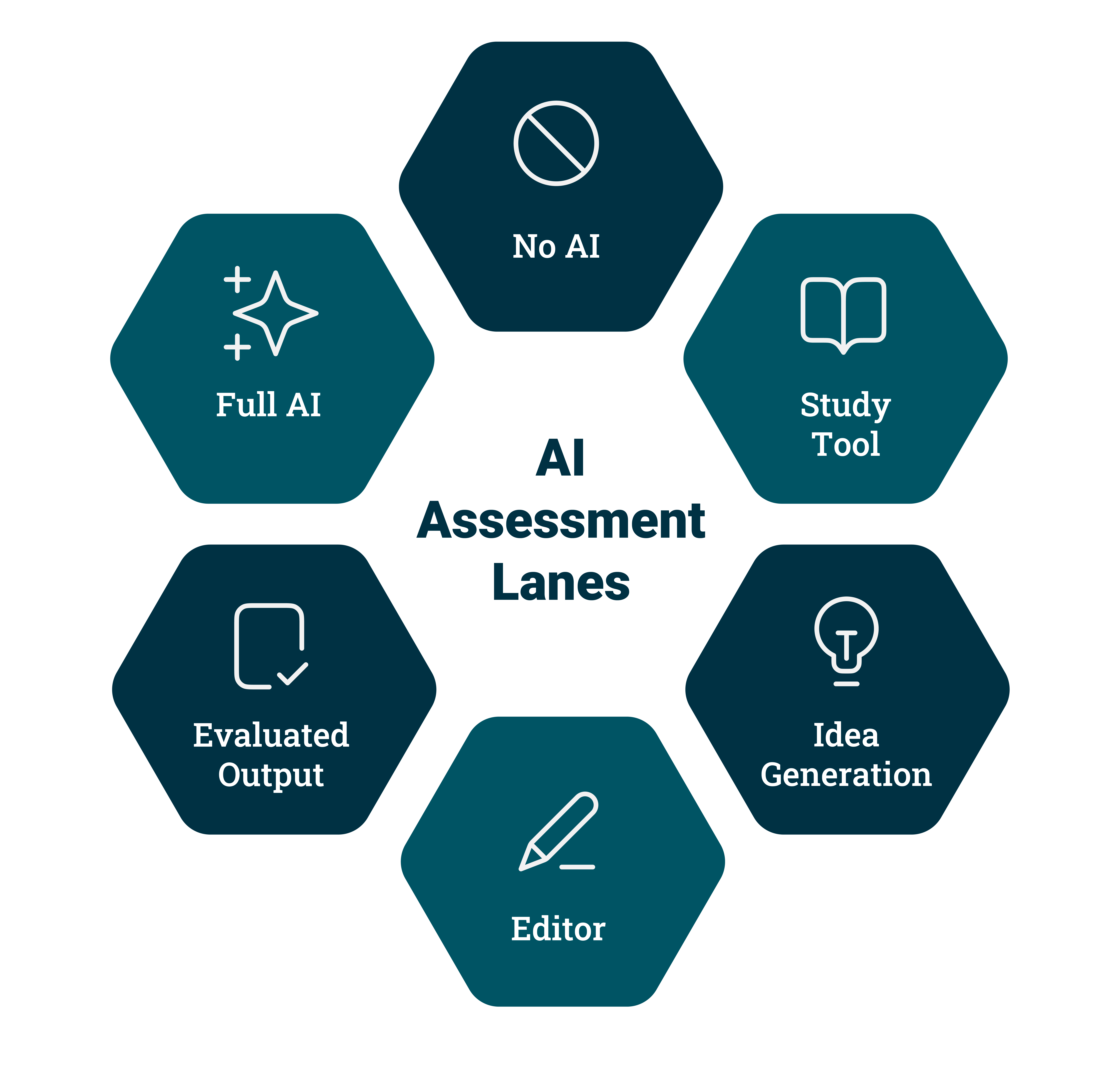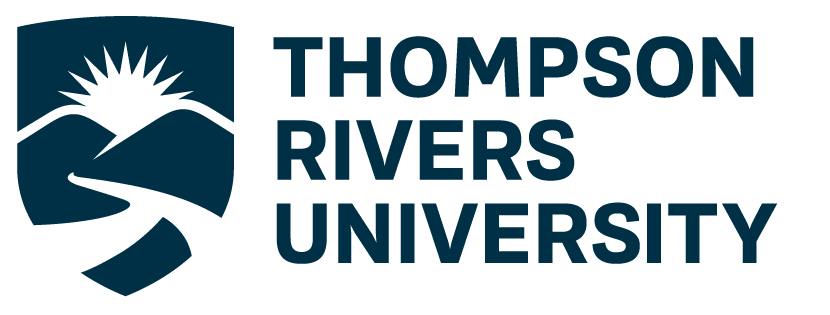Overview
At TRU, we recognize that faculty will approach GenAI in different ways—some may embrace it as a tool for innovation, while others may choose to limit or avoid its use. This site is here to support you in making those decisions by providing balanced, practical resources and examples grounded in TRU’s values of openness, respect, and curiosity.
Our goal is to offer guidance and resources that help you thoughtfully explore how GenAI may (or may not) fit within your courses. Whether you want to integrate AI into assignments, address its implications for assessment design, or provide students with advice on responsible use, we hope to learn alongside you as we navigate this rapidly changing terrain.
How do you want to use GenAI?
The GENAI Assessment Scale (Perkins et al., 2024) is a useful resource for educators, designed to help you define and communicate acceptable uses of Generative AI (GenAI) in your classroom. When considering this, it’s important to reflect on things such as:
- Is this an introductory or advanced course? What are positive and negative outcomes of GenAI use at this level?
- What skills are important for students to develop on their own for this assignment? What aspects or tasks in the assignment can GenAI assist with?
- What does the responsible use of GenAI look like and not look like for this assignment?

OR:

The GENAI Assessment scale provides educators a practical framework to guide the appropriate and ethical use of generative AI in assessment design through five specific levels of use.
The framework is…
The framework is NOT…
Each level targets specific ways of integrating and communicating allowed uses of Generative AI to students. Click the accordions below to learn more about each level, including methods for communicating student expectations. Please note which course assessments fall under each level. This is a starting point and can be adapted further for your context.
The assessment is completed entirely without AI assistance in a controlled environment, ensuring that students rely solely on their existing knowledge, understanding, and skills
Communicating Student Expectations
- The assessment requires your original demonstrations of course learning outcomes without AI assistance.
- This is to ensure that you are relying solely on your knowledge, understanding and skills to demonstrate learning.
- You must not use AI at any point during the assessment.
- Any AI tools used in your academic work may result in academic misconduct.
- You are permitted to use AI tools for study assistance; however, be mindful of not uploading intellectual property or personal information to these tools, as they can be used to further train their models and be exposed to parties that you did not grant permission for.
- It is not necessary to document the use of AI for the permitted purposes noted above. If you are ever unsure about whether a particular tool counts as AI or whether its use would be appropriate, please reach out to your instructor.
This assignment serves as an opportunity for me to evaluate your writing [e.g. critical thinking, research skills], so it is not an opportunity to make use of generative AI. Using generative AI for this assignment is a failure to demonstrate these skills, and if it is used, this will be reflected in your grade. If I have concerns about potential AI use in any part of your work, I’ll ask to meet with you to discuss the assignment in detail.
Notes for Instructors
This approach is used when you want a full original demonstration of student learning that aligns with the learning outcomes without the use of AI tools. This approach is ideal for testing core knowledge and comprehension. Attempting to fully ban GenAI in all assessments or police its use is neither realistic nor educationally sound in most cases.
Students may be using GenAI as a study tool, such as helping to explain concepts for their own learning or pose questions for themselves. You will not be able to monitor their use of GenAI for this purpose, so it is recommended that you discuss how GenAI can be used for this purpose both effectively, such as providing example prompts or tools that are safe to use, and responsibly, such as discussing issues surrounding data privacy and intellectual property.
The only way this approach is tenable is through a supervised, controlled environment in which the absence of GenAI can be assured. For example:
- In-class discussion
- In-class written document
- In-class quiz, test or mid-term (written or oral)
- Invigilated exam
This approach is challenging for online learning environments, and must accommodate students who rely on digital assistive technologies.
AI may be used for pre-task activities such as brainstorming, outlining and initial research. This level focuses on the effective use of AI for planning, synthesis, and ideation, but assessments should emphasize the ability to develop and refine these ideas independently.
Communicating Student Expectations
- The assessment requires demonstrations of course learning outcomes that allow for use of AI for brainstorming, idea generation, outlining, and initial research.
- You are responsible for developing, refining and presenting your own arguments, analyses and conclusions without the use of AI.
- You may use AI to enhance your own brainstorming, creation of structure of the assignment, and idea generation.
- AI may be used to construct outlines, perform searches, create draft notes, design slides, undertake analyses of data, suggest counter arguments, summarize literature, etc.
- There is to be no AI content in the final submission of the assessment.
- You may be required to include a reflective paragraph detailing what tool was used, how it was used, and when.
You may use AI for [planning, idea development, research etc.]. Your final submission should show how you have developed and refined these ideas.
Notes for Instructors
This approach is for when you are okay with students getting ideas and generating possible directions using GenAI as they may already do with friends, family and search engines.It is suitable for assessments for demonstrating writing skills. Students may use AI tools to generate ideas for an essay or report. AI may provide student assistance in getting started, expanding on initial thoughts or providing other perspectives.
This approach emphasises supporting students in developing their planning and ideation skills with AI as a collaborative tool. This requires carefully structured assessment components that distinguish between AI-supported planning phases and independent development while acknowledging that strict delineation between these phases may not be technically feasible.
Assessment design should acknowledge that while we cannot technically restrict AI use to planning stages, we can create tasks that meaningfully engage students in demonstrating their development of ideas. (Perkins, Roe, & Furze 2024, p.11)
AI may be used to help complete the task, including idea generation, drafting, feedback, and refinement. Students should critically evaluate and modify the AI suggested outputs, demonstrating their understanding.
Communicating Student Expectations
- The assessment requires demonstrations of course learning outcomes that will allow for use of AI for editing, refining and evaluating your work.
- AI may assist in the final quality of writing (spelling, punctuation, grammar, structure), word choice, clear and effective expression of ideas.
- You may use AI to receive feedback on draft versions or identify areas for improvement of writing and structure of the written assessment.
- You are responsible for deciding if the suggestions are appropriate and then appropriately incorporating them into your work.
- AI-generated content must be critically evaluated for accuracy, bias and citations while building your evaluative judgment skills.
- AI may complete some of the parts of the assessment and then you must discuss the results and make decisions about what is accurate, useful and relevant to the assessment.
- You may be required to include a reflective paragraph detailing which technologies and where in your assessment you used AI.
You may use AI to assist with specific tasks [such as drafting text, refining and evaluating your work]. You must critically evaluate and modify any AI-generated content you use.
Notes for Instructors
This approach allows students to use AI for drafting and composition while prioritising critical evaluation and preserving their own voice.
Faculty should help students understand AI’s limitations and reinforce that their knowledge, critical thinking, and subject expertise remain essential to high-quality academic work. This includes developing critical AI literacy (CAIL), spotting errors or biases, and integrating AI-generated content with their own insights so their voice is retained.
Technological authorship verification tools, such as document tracking, are unreliable and can disadvantage students without access to advanced AI models or the technical skills to use them effectively (Perkins, Roe, & Furze, 2024, p. 12).
This approach works best for assessments that encourage deep engagement with course materials, independent learning, and critical evaluation of AI outputs. Examples include having students analyze AI-generated results, compare them with other sources, and identify what is accurate and what is not.
AI may be used to complete any elements of the task, with students directing AI to achieve the assessment goals. Assessments at this level may also require engagement with AI to achieve goals and solve problems.
Communicating Student Expectations
- AI is used as a co-pilot to enhance creativity and meet learning outcomes.
- This lane is suitable when your work may be based on an earlier organization, idea generation, discussion, oral activity or other methods.
- AI acts as an assistant helping you organize your thoughts, integrate various viewpoints and present findings in a creative manner.
- You may use tools that help you draft outlines, suggest structure, or even provide initial content that you can build upon and refine.
- You may be required to include a reflective paragraph detailing which technologies and where in your assessment you used AI.
You may use AI [extensively throughout your work either as you wish, or as specifically directed in your assessment]. Focus on directing AI to achieve your goals while demonstrating your critical thinking
Notes for Instructors
This approach marks a shift toward strategically integrating AI tools to achieve defined learning outcomes. At this level, students demonstrate not only subject knowledge and critical thinking but also the ability to direct AI effectively, moving the focus from restricting AI use to assessing its purposeful application.
Equity of access is essential. Providing institutional tools, such as Copilot, or designing tasks achievable with free resources can help, though not perfectly. Transparency about permitted tools sets clear expectations. This approach also enables multimodal assessments, where AI supports outputs, such as video, synthetic media, or mixed formats, that extend beyond what students could realistically produce alone within time limits.(Perkins, Roe, & Furze 2024, p.13).
AI is used creatively to enhance problem-solving, generate novel insights, or develop innovative solutions to solve problems. Students and educators co-design assessments to explore unique AI applications within the field of study.
Communicating Student Expectations
- Design and carry out original AI projects that go beyond existing templates or simple multimodal generation.
- Work with your instructor to create innovative methods, media, or outputs that cross traditional disciplinary boundaries.
- Apply AI to complex, future-focused challenges such as building world models, generating bespoke datasets, or creating adaptive systems.
- Think critically about your use of AI by evaluating its role, judging its effectiveness, and ensuring your work remains authentic and demonstrates strategic tool use.
You should use AI creatively to solve the task, potentially co-designing new approaches with your instructor.
Notes for Instructors
At Level 5, instructors shift from directing tasks to collaborating with students in the co-creation of innovative, AI-enabled assessments. The focus is on reimagining academic work rather than simply adapting existing tasks for AI integration, encouraging boundary-challenging and cross-disciplinary outputs.
Equity remains essential, but the emphasis moves toward providing equal opportunities for experimentation through access to institutional AI resources, self-hosted models, APIs, or discipline-specific tools.
Assessments should be flexible, adaptable, and responsive to emerging technologies, targeting advanced undergraduate, postgraduate, doctoral, or other high-level independent projects where autonomy, creativity, and innovation are central.
Please work with us
This resource will continue to evolve as new developments emerge and as we learn from our practices. Please pass on materials or perspectives that we can share here. We are always keen to work with your department or faculty, and if you’d like us to facilitate a workshop or collaborate on a project please drop us a line.
